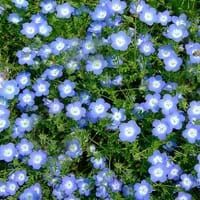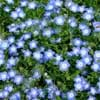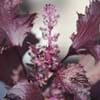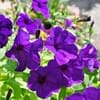Life Span
Annual
Annual and Perennial
Type
Flowering Plants, Herbs
Bulb or Corm or Tuber
Origin
Western United States, Alaska, California
Central America, South America
Types
Nemophila menziesii var. atomaria, Nemophila menziesii var. integrifolia, Nemophila menziesii var. menziesii
Vine, Flowering plant
Habitat
Chaparral, Grassland
All sorts of environments, Along Railroads, Banks, Moist Ditches, Roadsides, rocky banks of streams
USDA Hardiness Zone
3-9
10-13
AHS Heat Zone
Not Available
12-1
Sunset Zone
A1, A2, A3, H1, H2, 1a, 1b, 2a, 2b, 3a, 3b, 4, 5, 6, 7, 8, 9, 10, 11, 12, 13, 14, 15, 16, 17, 18, 19, 20, 21, 22, 23, 24
21,22
Habit
Cushion/Mound-forming
Vining/Climbing
Minimum Width
Not Available
Flower Color
White, Blue, Light Blue, Sky Blue
Purple, Rose
Flower Color Modifier
Bicolor
Bicolor
Fruit Color
Not Available
Not Available
Leaf Color in Spring
Green
Purple, Dark Green, Black
Leaf Color in Summer
Green
Light Green
Leaf Color in Fall
Not Available
Several shades of Green
Leaf Color in Winter
Light Green
Light Green
Leaf Shape
Lobed
Acicular
Plant Season
Spring, Summer, Winter
Spring, Summer, Fall, Winter
Sunlight
Full Sun, Partial Sun
Full Sun, Partial Sun
Growth Rate
Very Fast
Very Fast
Type of Soil
Loam, Sand
Clay, Loam, Sand
The pH of Soil
Acidic, Neutral
Acidic, Neutral, Alkaline
Soil Drainage
Well drained
Well drained
Bloom Time
Early Spring, Spring, Late Spring, Winter, Late Winter
Late Spring, Early Summer, Summer, Late Summer, Early Fall, Fall, Late Fall
Tolerances
Drought
Drought
Where to Plant?
Ground
Container, Ground
How to Plant?
Seedlings
Cuttings, Leaf Cutting, Tuber propagation
Plant Maintenance
Medium
Medium
Watering Requirements
Do not water frequently, Never Over-water
Keep the Soil well drained, Needs very little water
In Summer
Lots of watering
Lots of watering
In Spring
Moderate
Moderate
In Winter
Average Water
Average Water
Soil pH
Acidic, Neutral
Acidic, Neutral, Alkaline
Soil Type
Loam, Sand
Clay, Loam, Sand
Soil Drainage Capacity
Well drained
Well drained
Sun Exposure
Full Sun, Partial Sun
Full Sun, Partial Sun
Pruning
Not Available
Remove damaged leaves, Remove dead branches, Remove dead leaves
Fertilizers
All-Purpose Liquid Fertilizer
All-Purpose Liquid Fertilizer
Pests and Diseases
Red blotch
Red blotch
Plant Tolerance
Drought
Drought
Flower Petal Number
Single
Single
Foliage Texture
Fine
Coarse
Foliage Sheen
Not Available
Matte
Attracts
Bees, Butterflies
Aphids, Beetles, Cutworms, Insects, Mites, Whiteflies
Allergy
Not Available
Abdominal pain, allergic reaction, Nausea, Skin rash, Twitching of face
Aesthetic Uses
Beautification, Bouquets, Showy Purposes
Not Used For Aesthetic Purpose
Beauty Benefits
Not Available
Not Available
Environmental Uses
Air purification
Air purification
Medicinal Uses
Pain killer
Cures constipation, Fiber, Low calories, lowering blood pressure, Potassium, ß-carotene, Vitamin A, Vitamin C
Part of Plant Used
Flowers
Leaves, Root, Shoots, Stem, Tuber
Other Uses
Not Available
Starch, Used As Food, Used as Ornamental plant
Used As Indoor Plant
No
Sometimes
Used As Outdoor Plant
Yes
Yes
Garden Design
Bedding Plant, Container, Hanging Basket, Mixed Border, Wildflower
Container, Edible, Groundcover, Hanging Basket, Herb / Vegetable, Mixed Border, Rock Garden / Wall, Vine
Botanical Name
NEMOPHILA menziesii
IPOMOEA batatas 'Blackie'
Common Name
Baby Blue Eyes
Blackie Sweet Potato Vine, Sweet Potato Vine
In Hindi
Baby Blue Eyes Plant
शकरकन्द
In German
Baby Blue Eyes Pflanzen
Süßkartoffel
In French
bébé yeux bleus usine
Patate douce
In Spanish
bebé ojos azules planta
Ipomoea batatas
In Greek
μωρό μπλε μάτια των φυτών
Sweet potato
In Portuguese
bebê olhos azuis planta
Batata-doce
In Polish
dziecko niebieskie oczy roślin
Wilec ziemniaczany
In Latin
baby blue eyes plant
Ipomoea batatas
Phylum
Not Available
Tracheophyta
Class
Magnoliopsida
Magnoliopsida
Order
Not Available
Solanales
Family
Boraginaceae
Convolvulaceae
Clade
Angiosperms, Asterids, Eudicots
Angiosperms, Asterids, Eudicots
Tribe
Not Available
Not Available
Subfamily
Hydrophylloideae
Not Available
Number of Species
Not Available
Importance of Baby Blue Eyes Plant and Sweet Potato Vine
Want to have the most appropriate plant for your garden? You might want to know the importance of Baby Blue Eyes Plant and Sweet Potato Vine. Basically, these two plants vary in many aspects. Compare Baby Blue Eyes Plant and Sweet Potato Vine as they differ in many characteristics such as their life, care, benefits, facts, etc. Every gardener must at least have the slightest clue about the plants he wants to plant in his garden. Compare their benefits, which differ in many ways like facts and uses. The medicinal use of Baby Blue Eyes Plant is Pain killer whereas of Sweet Potato Vine is Cures constipation, Fiber, Low calories, lowering blood pressure, Potassium, ß-carotene, Vitamin A and Vitamin C. Baby Blue Eyes Plant has beauty benefits as follows: Not Available while Sweet Potato Vine has beauty benefits as follows: Not Available.
Compare Facts of Baby Blue Eyes Plant vs Sweet Potato Vine
How to choose the best garden plant for your garden depending upon its facts? Here garden plant comparison will help you to solve this query. Compare the facts of Baby Blue Eyes Plant vs Sweet Potato Vine and know which one to choose. As garden plants have benefits and other uses, allergy is also a major drawback of plants for some people. Allergic reactions of Baby Blue Eyes Plant are Not Available whereas of Sweet Potato Vine have Abdominal pain, allergic reaction, Nausea, Skin rash and Twitching of face respectively. Having a fruit bearing plant in your garden can be a plus point of your garden. Baby Blue Eyes Plant has no showy fruits and Sweet Potato Vine has no showy fruits. Also Baby Blue Eyes Plant is not flowering and Sweet Potato Vine is not flowering . You can compare Baby Blue Eyes Plant and Sweet Potato Vine facts and facts of other plants too.





